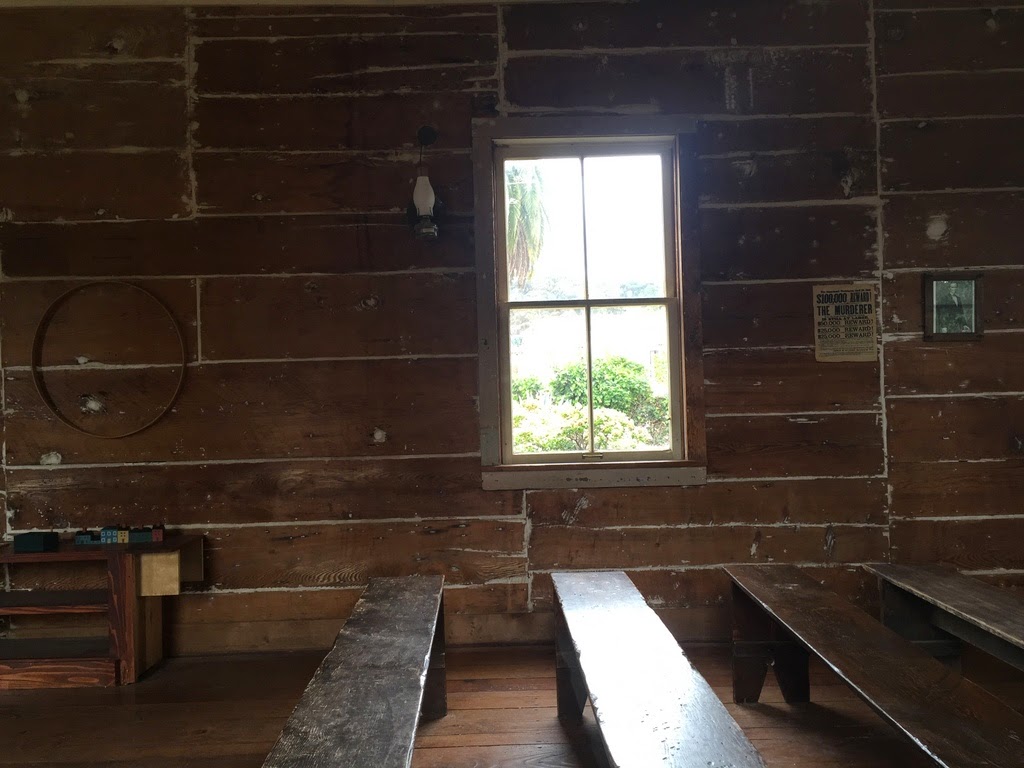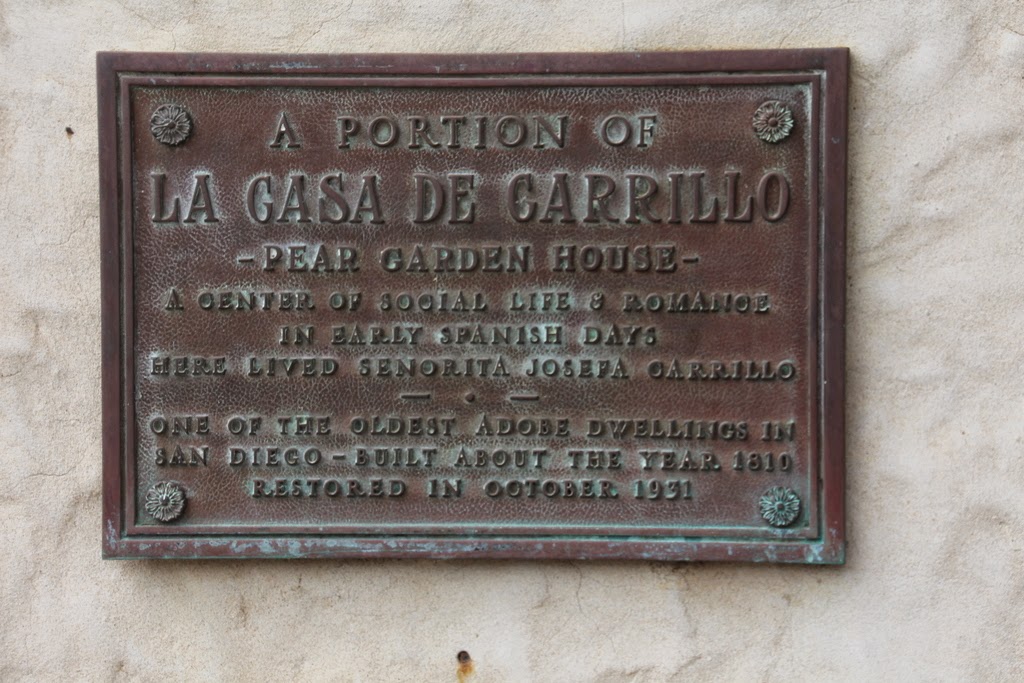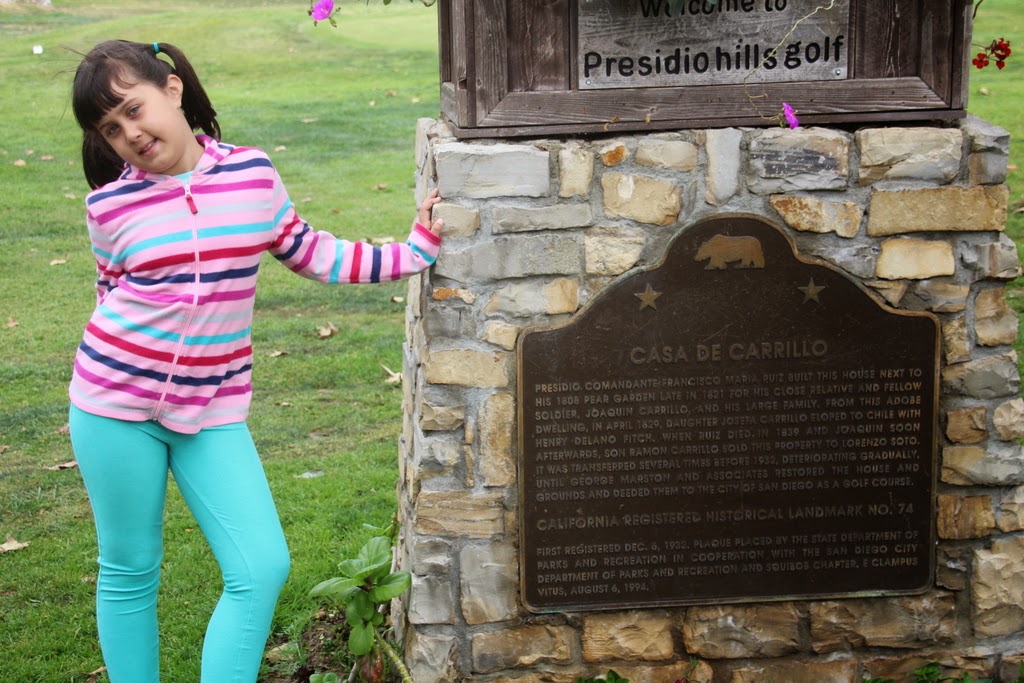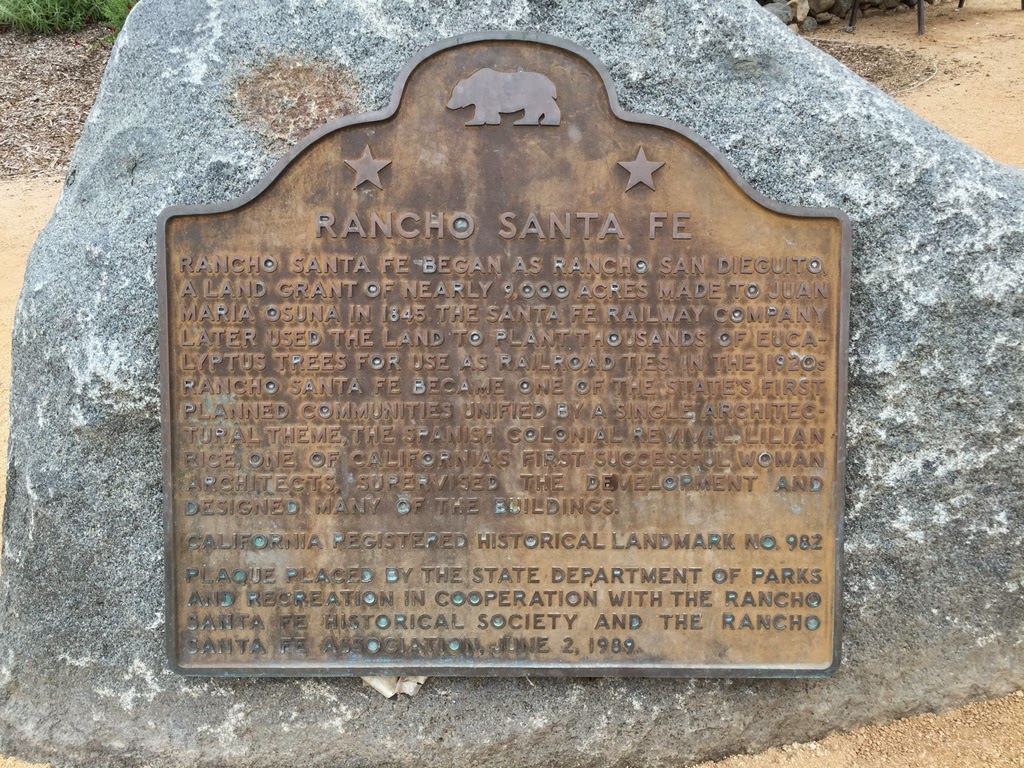After a quick breakfast at a Diners, Drive-Ins, and Dives joint in the Hillcrest neighborhood we re-started our CHL quest. Our first stop was up the hill from Old Town-- the San Diego Presidio Site (CHL 59). We now only have the Monterey presidio left-- we have seen the others.
This hill was first occupied on May 17, 1769 and two months later Father Serra established the first San Diego Mission here.
We accidentally passed Fort Stockton-- so we will have to turn around and go back for that. However, before we do there are two sites at the bottom of the hill! The first was
Derby Dike (CHL 244).
This was one of the first US Government projects in California-- a dike built by Lieutenant George Horatio Derby to protect Old Town San Diego.
George Derby was quite a colorful guy-- he went to West Point with Ulysses S. Grant, he was one of California's first humorists who was said have influenced Mark Twain and Bret Harte, and he had two pen-names John P. Squibob and John Phoenix.
Our next site was the
Serra Palm site (CHL 67) where in 1769 Padre Serra planted a palm tree.
This is also the beginning of the El Camino Real and where the Portola Expedition met on July 1, 1769.
The tree no longer exists, but they say that part of it is in a local museum.
We drove back up the hill, past the presidio to
Fort Stockton (CHL 54).
From the state: Fortified briefly by Carlos Carrillo in 1838, this site became Fort Dupont (July – November 1846) after American forces took Old Town during the Mexican War, retaken and held briefly by the Californios, if fell once more to the Americans, who renamed it Fort Stockton and used it as campaign headquarters for ending the Californio revolt in early 1847. The Mormon Battalion stayed here later that year. The post was abandoned on September 25, 1848.
Sadly the plaque has been defaced.
Since this was the sight where the Mormon Battalion stayed there are several plaques commemorating that as well.
This particular one was left by the Sons of Utah Pioneers.
There is a Mormon Battalion Museum in Old Town that Libi really wanted to visit. Next time we will have to make a stop there to learn more about this group.
Libi and Ron even got into the mural as some of the pioneers in the battalion.
Happily, most of these San Diego landmarks are clearly marked!
Now we begin our walking tour of Old Town. Our first stop was the
Whaley House (CHL 65).
This was the first brick structure in San Diego County-- the bricks were made in an Old Town kiln and the plaster was made of ground seashells. It was originally build for the Whaley family who lived here for five generations and the San Diego Court met here for about 20 years.
It is now apparently haunted-- so they do spooky tours every night. Due to that fact, Libi wouldn't go anywhere near the inside.
Since we are on the haunted theme-- we went to El Campo Santo (CHL 68), the cemetery dating back to the 1850's.
Many San Diego pioneers are buried here as well as some Native Americans.
A street railway bisected the cemetery in 1894 and many of the graves have been relocated. They also found about 20 graves below the street...
So you see these markers in the road to indicate those graves.
As I said previously, this is also a site that they include on the haunted Old Town walking tours.
We were earning a Girl Scout Old Town badge while we were there as well and we learned that there is a woman interred here who lived to be 108!
This is one of the first wooden signs we have seen leading folks to a historic landmark.
A short walk away we came to the
Chapel of the Immaculate Conception aka Old Adobe Chapel (CHL 49).
Sadly, the gates were locked today, so we couldn't go inside. Ron decided to put Libi up on the retaining wall to get better photos...
You can see how well Libi liked that idea with her facial expression here:
This was originally the home of John Brown. It was converted into a church in 1858 by Don Jose Aguirre. This is not the original building-- it was bulldozed due to street construction. It was rebuilt by the WPA in 1937.
Father Antonio D. Ubach was the parish priest here from 1866-1907-- he is said to be the model for Father Gaspara from Helen Hunt Jackson's novel Ramona. This is not the only time we will hear about this book in Old Town!
The next site was on the side of a restaurant located on a side street in Old Town-- Casa de Lopez (CHL 60).
The home was built in 1835 by Juan Francisco Lopez, an early Spanish settler.
In looking for more information about Juan Francisco Lopez I came upon an account of the explorers on the Anza expedition: Maria Feliciana Arballo, Private Citizen – Arballo, the widow who sang bawdy songs and embarrassed Fray Font at the campsite on San Felipe Creek, quit the expedition at San Gabriel to marry a soldier named Juan Francisco Lopez. Her daughter, Maria Estaquia, who had traveled over the entire trail with Arballo, married a son of Santiago de la Cruz Pico and gave birth to Pio Pico, the governor. Arballo’s daughter, Maria Ignacia Lopez de Carrillo, by Juan Francisco Lopez, lies buried in the ruins of the San Francisco Solano mission at Sonoma, beneath the original location of the font, where holy water streaming from the hands of the devout once fell on her grave.
In 1846 the home changed ownership and belonged to Juan Matias Moreno, Pio Pico's secretary.
The Site of Casa de Cota (CHL 75) has no actual site and no state plaque, just a brown sign in a parking lot. This was the site of an adobe built by Juan or Ramon Cota in 1835. There isn't much information about the house or the Cotas-- but apparently the adobe stood for over 100 years on this site before being bulldozed by the Army during WWII. The San Diego Historical Society does have photos of the adobe you can see
here.
Now we really headed into the Old Town State Historic Park to
Casa de Pedrorena (CHL 70).
This was the home of Miguel de Pedrorena who served as a member of the Constitutional Convention at Monterey in 1849.
He was born in Spain, educated in England, and then moved to San Diego where he was given much land. His family has ties to many other prominent, early San Diego pioneers.
At first we thought there was no site left for our next landmark, so we took a photo of Libi by the state park sign...
however when we rounded the corner we saw that the restoration of the building for
Casa de Stewart (CHL 73) is going strong! This adobe was constructed by Jose Manuel Macahdo for his daughter Rosa in the 1830's. Rosa was married to John C. Stewart who was shipmate to author Richard Henry Dana, Jr. who wrote about visiting the home in his book
Two Years Before the Mast. It appears that eventually they want this to be a museum. You can see a fascinating piece about the restoration and history of the adobe
here.
We walked about three feet to the next site-- the
First Publicly-Owned School Building (CHL 538).
In 1865 the Mason Street School was the first public schoolhouse in San Diego County.
Mary Chase Walker was the first school teacher here and she made $65 per month! She resigned after an incident when she invited a black woman to lunch with her. The community was outraged and her attendance dropped from 35 children to 15.
You can read more about this fascinating educator
here.
Libi had to get a picture with her favorite teacher!
The schoolhouse is open for tours, but sadly we were there too early.
Ron manage to get these photos through the window.
Just around the corner was
Casa de Estudillo (CHL 53).
In this home three generations of Don Jose Maria Estudillo's family lived. His daughter married Miguel de Pedrorena whose home we visited a few sites ago.
This house is often mistakenly referred to as Ramona's wedding place from the book by Helen Hunt Jackson.
Libi is standing on the approximate site for the Exchange Hotel (CHL 491). There is no site left and no plaque either (despite what the state's write-up says), so we had to improvise.
At this hotel, the Masons met for the first time in San Diego to organize their lodge. Very little is known about the actual hotel-- as no photos of it can be found. The San Diego Historical Society does have some cool anecdotal stories about events that happened here, the men who were the owners, and the plaque ceremony but we couldn't find any evidence of the plaque.
In the middle of the grass area we came to the Plaza, San Diego Viejo aka Washington Square (CHL 63).
This was the center of the Mexican Pueblo of San Diego. On July 29, 1846, Lt. Stephen C. Rowan from the sloop of war
Cyane raised the American Flag over the plaza. Rowan has a long and proud Navy service-- fighting in the Mexican-American War as well as the Civil War.
These next two sites are actually on the same plot of land-- Casa de Machado (CHL 71) and Congress Hall Site (CHL 66). There is nothing left of the Congress Hall site-- it was formerly located right behind this bulletin board that Libi is standing in front of. It was a two-story public house built in 1867 by George Dewitt Clinton Washington Robinson that housed Pony Express offices.
The Casa de Machado was an adobe house built in 1832 by Jose Manuel Machado. It has since been a church and a restaurant, but it seems to be deserted right now.
On the wall of a restaurant on the far side of Old Town we found
Old Town San Diego State Park (CHL 830).
From the state: Settled by pensioned soldiers from the presidio and their families, Old Town grew into a cluster of adobe houses and garden plots in the early 1800s. By 1835, 'it was composed of about 40 dark brown looking huts.' The Stars and Stripes was first raised over the plaza in 1846 by Marines from the U.S.S. Cyane.
Outside of the Old Town Park, across the street in a municipal golf course is Casa de Carrillo (CHL 74).
The adobe house was originally built by Presidio Comandante Francisco Maria Ruiz for his relative Joaquin Carrillo and family.
The house changed ownership many times before it was deeded to the city to be used as a golf course. The pro-shop is now in the adobe house.
Casa de Bandini (CHL 72) proved challenging for us to find. Ron and I both vividly remember seeing a large building that had a Mexican restaurant in it labeled as "Casa de Bandini" every time we came to Old Town. We looked all over and couldn't find the building-- it has since changed names which made it nearly impossible for us to find.
The adobe was built by Jose and Juan Bandini around 1827.
It was the headquarters of Commodore Robert F. Stockton in 1846.
A short drive away from Old Town is the
Site of the Kate O. Sessions Nursery (CHL 764).
Kate Sessions opened a nursery on this site and became a world famous horticulturalist. She had a vision for a more beautiful San Diego and was the first woman to receive the International Meyer Medal in genetics. She is known as the Mother of Balboa park due to her leasing the land on which is now the park and planting 100 trees per year of her lease on the property as well as 300 trees elsewhere in San Diego.
Next we drove to the
Historic Planned Community of Rancho Santa Fe (CHL 982).
This was one of the state's first planned communities that is unified by a single architectural theme-- the Spanish Colonial Revival. There are also tons of eucalyptus trees that were planted here by the Santa Fe Railroad to use for railroad ties.
Leo Carrillo Ranch (Rancho de Los Kiotes) was next CHL 1020.
This adobe and ranch was built by actor Leo Carillo between 1937 and 1940.
Leo Carillo believed in honoring California's Spanish heritage thought charity and his way of life.
He and his celebrity friends spent many happy times here on the ranch-- you can see some of their adventures in the visitors center on a lovely video.
We spent a great deal of time exploring the grounds and searching for the state plaque.
We found lots of neat surprises including beautiful flowers and peacocks...
and eventually after hiking to the lower property, we did find the plaque!
You can actually watch the visitor's center video
here.
Next we drove to Rancho Guajome (CHL 940).
This adobe used to be part of Mission San Luis Rey. It has also been owned by two mission Indians.
Sadly the adobe wasn't open for tours today-- but we at least got to see it from the outside.
They have a cool gift shop and some examples of period farming tools on display in areas we could see.
Our final stop for the day was
Mission San Luis Rey de Francia (CHL 239).
This was the 18th mission founded in California. It was established in 1798 by Father Lasuen.
It's nickname was King of the Missions-- I'm unclear if that's because of its size or because it was named after the King of France.
It was a lovely mission...
we did a short self-guided walking tour.
We are now about half way done with the missions.
Each one has their own character and charm...
and, of course, lots of cool archways for photos!
































































































